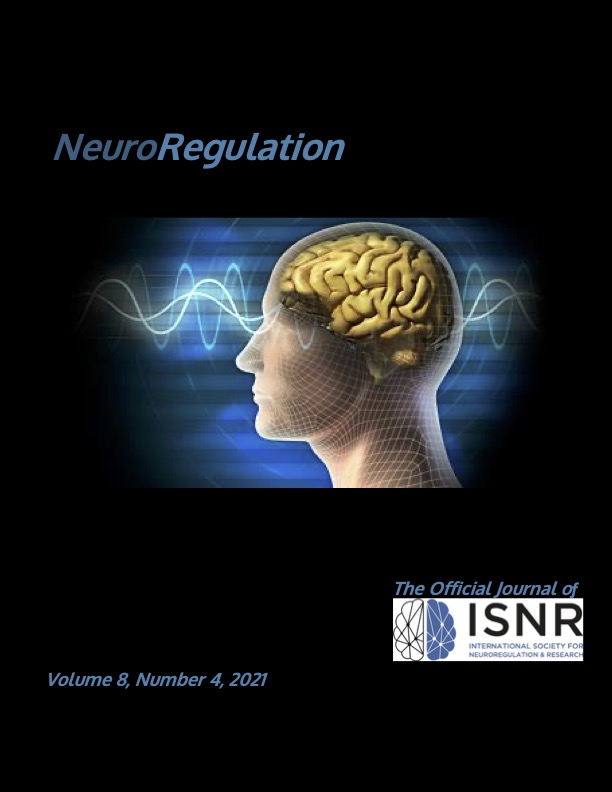How a Chronic Headache Condition Became Resolved with One Session of Breathing and Posture Coaching
DOI:
https://doi.org/10.15540/nr.8.4.194Keywords:
headache, breathing, posture, awareness, electromyographyAbstract
This case example reports how a 32-year-old female student with chronic headaches since age 18 became headache-free after one session of breathing and posture coaching. She self-medicated and took between 2 and 10 Excedrin tablets per week. The class coaching session focused on shifting her habitual thoracic breathing to slower lower abdominal diaphragmatic breathing and posture retraining. While working at the computer, she used an app installed on her computer that provided visual and auditory feedback each time she slouched. She used the app 2–6 hours per day for 2 weeks, and each time in response to the slouching feedback she sat up erect and breathed slower and lower. After the first coaching session and for the following 14 weeks, she has been headache-free and not used any medications. After implementing breathing and posture changes, she also reported significant reduction in shoulder pain, back pain, depression, anxiety, and improvement in motivation. We recommend that when college students report headaches, anxiety, and gastrointestinal distress that they are first offered self-mastery interventions.
References
Ahmed, S., Akter, R., Pokhrel, N., & Samuel, A. J. (2021). Prevalence of text neck syndrome and SMS thumb among smartphone users in college-going students: A cross-sectional survey study. Journal of Public Health, 29, 411–416. https://doi.org/10.1007/s10389-019-01139-4
Bauer, A. Z., Swan, S. H., Kriebel, D., Liew, Z., Taylor, H. S., Bornehag, C.-G., Andrade, A. M., Olsen, J., Jensen, R. H., Mitchell, R. T., Skakkebaek, N. E., Jégou, B., & Kristensen, D. M. (2021). Paracetamol use during pregnancy — A call for precautionary action. Nature Reviews Endocrinology, 17, 757–766. https://doi.org/10.1038/s41574-021-00553-7
Charles, N. E., Strong, S. J., Burns, L. C., Bullerjahn, M. R., & Serafine, K. M. (2021). Increased mood disorder symptoms, perceived stress, and alcohol use among college students during the COVID-19 pandemic. Psychiatry Research, 296, 113706. https://doi.org/10.1016/j.psychres.2021.113706
Elizagaray-Garcia, I., Beltran-Alacreu, H., Angulo-Díaz, S., Garrigós-Pedrón, M., & Gil-Martínez, A. (2020). Chronic primary headache subjects have greater forward head posture than asymptomatic and episodic primary headache sufferers: Systematic review and meta-analysis. Pain Medicine, 21(10), 2465–2480. https://doi.org/10.1093/pm/pnaa235
Greden, J. F., Victor, B. S., Fontaine, P., & Lubetsky, M. (1980). Caffeine-withdrawal headache: A clinical profile. Psychosomatics, 21(5), 411–413, 417–418. https://doi.org/10.1016/S0033-3182(80)73670-8
Küçer, N. (2010). The relationship between daily caffeine consumption and withdrawal symptoms: A questionnaire-based study. Turkish Journal of Medical Sciences, 40(1), 105–108. https://doi.org/10.3906/sag-0809-26
Kuehn, B. M. (2021). Increase in myopia reported among children during COVID-19 lockdown. JAMA, 326(11), 999. https://doi.org/10.1001/jama.2021.14475
MacHose, M. & Peper, E. (1991). The effect of clothing on inhalation volume. Biofeedback and Self-regulation, 16, 261–265. https://doi.org/10.1007/BF01000020
Peper, E., Booiman, A., Lin, I.-M., Harvey, R., & Mitose, J. (2016b). Abdominal SEMG feedback for diaphragmatic breathing: A methodological note. Biofeedback, 44(1), 42–49. https://doi.org/10.5298/1081-5937-44.1.03
Peper, E., Gilbert, C. D., Harvey, R. & Lin, I.-M. (2015). Did you ask about abdominal surgery or injury? A learned disuse risk factor for breathing dysfunction. Biofeedback, 43(4), 173–179. https://doi.org/10.5298/1081-5937-43.4.06
Peper, E., Lin, I.-M., Harvey, R., & Perez, J. (2017b). How posture affects memory recall and mood. Biofeedback. 45(2), 36¬–41. https://doi.org/10.5298/1081-5937-45.2.01
Peper, E., Mason, L., Harvey, R., Wolski, L., & Torres, J. (2020). Can acid reflux be reduced by breathing? Townsend Letter, The Examiner of Alternative Medicine, 445/446, 44–47. https://www.townsendletter.com/article/445-6-acid-reflux-reduced-by-breathing/
Peper, E., Mason, L., & Huey, C. (2017a). Healing irritable bowel syndrome with diaphragmatic breathing. Biofeedback, 45(4), 83–87. https://doi.org/10.5298/1081-5937-45.4.04
Peper, E., Miceli, B., & Harvey, R. (2016a). Educational model for self-healing: Eliminating a chronic migraine with electromyography, autogenic training, posture, and mindfulness. Biofeedback, 44(3), 130–137. https://doi.org/10.5298/1081-5937-44.3.03
Peper, E., Wilson, V., Martin, M., Rosegard, E., & Harvey, R. (2021). Avoid Zoom fatigue, be present and learn. NeuroRegulation, 8(1), 47–56. https://doi.org/10.15540/nr.8.1.47
Schulman, E. A. (2002). Breath-holding, head pressure, and hot water: An effective treatment for migraine headache. Headache, 42(10), 1048–1050. https://doi.org/10.1046/j.1526-4610.2002.02237.x
Tsai, H.-Y., Peper, E., & Lin, I.-M. (2016). EEG patterns under positive/negative body postures and emotion recall tasks. NeuroRegulation, 3(1), 23–27. https://doi.org/10.15540/nr.3.1.23
Veenstra, L., Schneider, I. K., & Koole, S. L. (2017). Embodied mood regulation: the impact of body posture on mood recovery, negative thoughts, and mood-congruent recall. Cogntion and Emotion, 31(7), 1361–1376. https://doi.org/10.1080/02699931.2016.1225003
Wilson, V. E., & Peper, E. (2004). The effects of upright and slumped postures on the generation of positive and negative thoughts. Applied Psychophysiology and Biofeedback, 29(3), 189–195. https://doi.org/10.1023/b:apbi.0000039057.32963.34
Downloads
Published
Issue
Section
License
Authors who publish with this journal agree to the following terms:- Authors retain copyright and grant the journal right of first publication with the work simultaneously licensed under a Creative Commons Attribution License (CC-BY) that allows others to share the work with an acknowledgement of the work's authorship and initial publication in this journal.
- Authors are able to enter into separate, additional contractual arrangements for the non-exclusive distribution of the journal's published version of the work (e.g., post it to an institutional repository or publish it in a book), with an acknowledgement of its initial publication in this journal.
- Authors are permitted and encouraged to post their work online (e.g., in institutional repositories or on their website) prior to and during the submission process, as it can lead to productive exchanges, as well as earlier and greater citation of published work (See The Effect of Open Access).











